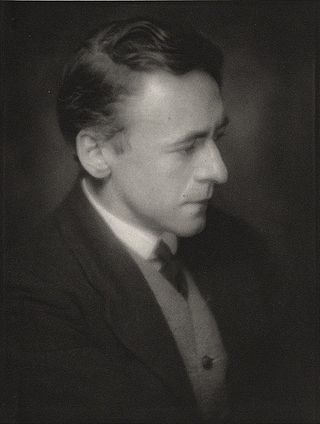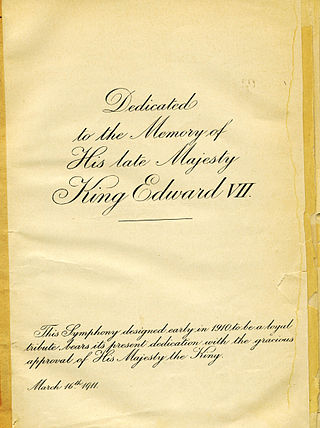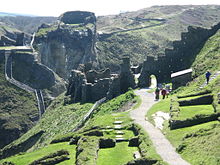
Sir Arnold Edward Trevor Bax, was an English composer, poet, and author. His prolific output includes songs, choral music, chamber pieces, and solo piano works, but he is best known for his orchestral music. In addition to a series of symphonic poems, he wrote seven symphonies and was for a time widely regarded as the leading British symphonist.

The Bournemouth Symphony Orchestra (BSO) is an English orchestra, founded in 1893 and originally based in Bournemouth. With a remit to serve the South and South West of England, the BSO is administratively based in the adjacent town of Poole, since 1979.

Sir Granville Ransome Bantock was a British composer of classical music.

Sir Edward Elgar's Symphony No. 2 in E♭ major, Op. 63, was completed on 28 February 1911 and was premiered at the London Musical Festival at the Queen's Hall by the Queen's Hall Orchestra on 24 May 1911 with the composer conducting. The work, which Elgar called "the passionate pilgrimage of the soul", was his last completed symphony; the composition of his Symphony No. 3, begun in 1933, was cut short by his death in 1934.

The Symphony No. 2 in E minor, Op. 27 by Russian composer Sergei Rachmaninoff was written from October 1906 to April 1907. The premiere was performed at the Mariinsky Theatre in Saint Petersburg on 26 January 1908, with the composer conducting. Its duration is approximately 60 minutes when performed uncut; cut performances can be as short as 35 minutes. The score is dedicated to Sergei Taneyev, a Russian composer, teacher, theorist, author, and pupil of Pyotr Ilyich Tchaikovsky. The piece remains one of the composer's most popular and best known compositions.
A London Symphony is the second symphony composed by Ralph Vaughan Williams. The work is sometimes referred to as Symphony No. 2, though the composer did not designate that name for the work. First performed in 1914, the original score of this four-movement symphony was lost and subsequently reconstructed. Vaughan Williams continued revisions of the work into its final definitive form, which was published in 1936.
Sir Eugene Aynsley Goossens was an English conductor and composer.
Vernon George "Tod" Handley was a British conductor, known in particular for his support of British composers. He was born of a Welsh father and an Irish mother into a musical family in Enfield, Middlesex. He acquired the nickname "Tod" because his feet were turned in at his birth, which his father simply summarised: "They toddle". Handley preferred the use of the name "Tod" throughout his life over his given names.

Symphonic Dances, Op. 45, is an orchestral suite in three movements completed in October 1940 by Russian composer Sergei Rachmaninoff. It is his final major composition, and his only piece written in its entirety while living in the United States.
The Overture to a Picaresque Comedy is a concert overture composed by Arnold Bax in 1930. It was premiered by the Hallé Orchestra conducted by the dedicatee, Sir Hamilton Harty, in November 1931. The work is untypical of its composer, who was not usually associated with comedy in music.
November Woods is a tone poem by Arnold Bax, written in 1917. Ostensibly a musical depiction of nature, the work conveys something of the composer's turbulent emotional state arising from the disintegration of his marriage and his love affair with the pianist Harriet Cohen. According to the composer, the piece is not programmatic, but evokes mood rather than painting a picture or telling a story.
Edward Elgar's Third Symphony Op. 88 (posth.) was incomplete at the time of his death in 1934. Elgar left 130 pages of sketches, which the British composer Anthony Payne worked on for many years, producing a complete symphony in 1997, officially known as "Edward Elgar: the sketches for Symphony No 3 elaborated by Anthony Payne" or in brief "Elgar/Payne Symphony No 3". The first public performance was at the Royal Festival Hall, London, on 15 February 1998, by the BBC Symphony Orchestra conducted by Andrew Davis.
Margaret Fingerhut is a British classical pianist. She is known for her innovative recital programmes and recordings in which she explores lesser known piano repertoire.
Arnold Bax composed his Piano Sonata in E-flat in 1921. It is the original version of Bax's First Symphony and was not performed in public or published in the composer's lifetime.
The Sea, H.100 is an orchestral suite written in 1910–11 by Frank Bridge. It is also described as a symphonic tone poem. It lasts about 22 minutes.
The Garden of Fand (1916) is a tone poem by the English composer Arnold Bax. It was inspired by an Irish mythical figure, Fand, the daughter of the lord of the ocean. The work does not portray the events of the mythical tale, but evokes Fand's island. The composer had been greatly influenced by Celtic culture in his earlier works, but described this one as his last in that vein.
In the Faëry Hills, to which the composer gave the alternative Irish title An Suagh Sidhe, is a symphonic poem by Arnold Bax. It was composed in 1909 and was premiered in London in 1910. It is the second of three works that make up a trilogy of symphonic poems with the collective title Eire. The inspiration for the piece was The Wanderings of Oisin by the poet W. B. Yeats, whom Bax greatly admired.
The Happy Forest is a symphonic poem by Arnold Bax. It was composed as a piano piece in 1914, and orchestrated in 1922. The inspiration for the work was a story of the same name by Herbert Farjeon, a rural idyll with mythical figures delighting the observer. Bax's treatment is an evocation of the mood of the story rather than a programmatic depiction of the incidents.
Christopher Whelen was an English composer, conductor and playwright, best known for his radio and television operas. Because much of his work was written for specific theatre productions in the 1950s, or directly for broadcast in the 1960s to the 1980s, little of it survives today though a number of his scores, etc, have now been deposited in the British Library.
Sam Hartley Braithwaite was a British composer and artist.






